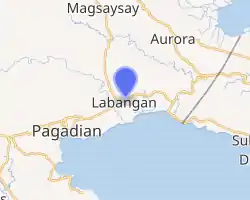Labangan, Zamboanga del Sur
Labangan, officially the Municipality of Labangan (Cebuano: Lungsod sa Labangan; Subanen: Benwa Labangan; Chavacano: Municipalidad de Labangan; Tagalog: Bayan ng Labangan), is a 3rd class municipality in the province of Zamboanga del Sur, Philippines. According to the 2015 census, it has a population of 41,790 people. [3]
Labangan | |
|---|---|
| Municipality of Labangan | |
 Map of Zamboanga del Sur with Labangan highlighted | |
OpenStreetMap 
| |
.svg.png.webp) Labangan Location within the Philippines | |
| Coordinates: 7°52′00″N 123°31′00″E | |
| Country | |
| Region | Zamboanga Peninsula (Region IX) |
| Province | Zamboanga del Sur |
| District | 2nd District |
| Founded | July 20, 1949 |
| Barangays | 30 (see Barangays) |
| Government | |
| • Type | Sangguniang Bayan |
| • Mayor | Eduardo D. Relacion |
| • Vice Mayor | Marlon B. Valenzuela |
| • Representative | Divina Grace C. Yu |
| • Electorate | 29,339 voters (2019) |
| Area | |
| • Total | 157.90 km2 (60.97 sq mi) |
| Elevation | 21 m (69 ft) |
| Population | |
| • Total | 41,790 |
| • Density | 260/km2 (690/sq mi) |
| • Households | 8,428 |
| Economy | |
| • Income class | 3rd municipal income class |
| • Poverty incidence | 33.64% (2015)[4] |
| • Revenue | ₱105,629,646.74 (2016) |
| Time zone | UTC+8 (PST) |
| ZIP code | 7017 |
| PSGC | |
| IDD : area code | +63 (0)62 |
| Climate type | tropical climate |
| Native languages | Subanon Cebuano Chavacano Tagalog |
Barangays
Labangan is politically subdivided into 25 barangays.
- Bagalupa
- Balimbingan (West Luya)
- Binayan
- Bokong
- Bulanit
- Cogonan
- Combo
- Dalapang
- Dimasangca
- Dipaya
- Langapod
- Lantian
- Lower Campo Islam (Poblacion)
- Lower Pulacan
- Lower Sang-an
- New Labangan
- Noboran
- Old Labangan
- San Isidro
- Santa Cruz
- Tapodoc
- Tawagan Norte
- Upper Campo Islam (Poblacion)
- Upper Pulacan
- Upper Sang-an
Climate
| Climate data for Labangan, Zamboanga del Sur | |||||||||||||
|---|---|---|---|---|---|---|---|---|---|---|---|---|---|
| Month | Jan | Feb | Mar | Apr | May | Jun | Jul | Aug | Sep | Oct | Nov | Dec | Year |
| Average high °C (°F) | 30 (86) |
31 (88) |
31 (88) |
32 (90) |
30 (86) |
30 (86) |
29 (84) |
29 (84) |
30 (86) |
29 (84) |
30 (86) |
30 (86) |
30 (86) |
| Average low °C (°F) | 23 (73) |
23 (73) |
23 (73) |
24 (75) |
24 (75) |
24 (75) |
24 (75) |
24 (75) |
24 (75) |
24 (75) |
24 (75) |
23 (73) |
24 (74) |
| Average precipitation mm (inches) | 48 (1.9) |
44 (1.7) |
56 (2.2) |
56 (2.2) |
112 (4.4) |
135 (5.3) |
124 (4.9) |
124 (4.9) |
115 (4.5) |
134 (5.3) |
90 (3.5) |
56 (2.2) |
1,094 (43) |
| Average rainy days | 13.0 | 11.7 | 15.6 | 18.1 | 25.6 | 25.7 | 25.2 | 24.1 | 23.8 | 26.1 | 22.3 | 16.5 | 247.7 |
| Source: Meteoblue [5] | |||||||||||||
Demographics
| Year | Pop. | ±% p.a. |
|---|---|---|
| 1960 | 12,921 | — |
| 1970 | 15,965 | +2.14% |
| 1975 | 16,257 | +0.36% |
| 1980 | 18,473 | +2.59% |
| 1990 | 29,229 | +4.70% |
| 1995 | 32,264 | +1.87% |
| 2000 | 34,530 | +1.47% |
| 2007 | 37,598 | +1.18% |
| 2010 | 39,168 | +1.50% |
| 2015 | 41,790 | +1.24% |
| Source: Philippine Statistics Authority [3] [6] [7][8] | ||
Attractions
- Pulacan Falls - 12 km. from Pagadian City, and covering an area of 400 square meters. It is the source of water for the Labangan irrigation system. Two kilometers from the area is the 134-hectare Home Defense Center. The falls can be reached easily by any motor vehicle. With the opening of the PADAP road, Pulacan Falls became a beautiful camping and picnic site. It now has a permanent Boy and Girl Scout site with facilities and has been the location of regional and provincial jamborees.
- Army Site - The new division site of 1st Infantry (TABAK) Division, Philippine Army, is located on the top of the Hill of Kuta Major Cesar L Sang-an.
References
- Municipality of Labangan | (DILG)
- "Province: Zamboanga del Sur". PSGC Interactive. Quezon City, Philippines: Philippine Statistics Authority. Retrieved 12 November 2016.
- Census of Population (2015). "Region IX (Zamboanga Peninsula)". Total Population by Province, City, Municipality and Barangay. PSA. Retrieved 20 June 2016.
- "PSA releases the 2015 Municipal and City Level Poverty Estimates". Quezon City, Philippines. Retrieved 12 October 2019.
- "Labangan: Average Temperatures and Rainfall". Meteoblue. Retrieved 1 May 2020.
- Census of Population and Housing (2010). "Region IX (Zamboanga Peninsula)". Total Population by Province, City, Municipality and Barangay. NSO. Retrieved 29 June 2016.
- Censuses of Population (1903–2007). "Region IX (Zamboanga Peninsula)". Table 1. Population Enumerated in Various Censuses by Province/Highly Urbanized City: 1903 to 2007. NSO.
- "Province of Zamboanga del Sur". Municipality Population Data. Local Water Utilities Administration Research Division. Retrieved 17 December 2016.
External links
This article is issued from Wikipedia. The text is licensed under Creative Commons - Attribution - Sharealike. Additional terms may apply for the media files.